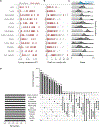A database of tissue-specific rhythmically expressed human genes has potential applications in circadian medicine
- PMID: 30209245
- PMCID: PMC8961342
- DOI: 10.1126/scitranslmed.aat8806
A database of tissue-specific rhythmically expressed human genes has potential applications in circadian medicine
Abstract
The discovery that half of the mammalian protein-coding genome is regulated by the circadian clock has clear implications for medicine. Recent studies demonstrated that the circadian clock influences therapeutic outcomes in human heart disease and cancer. However, biological time is rarely given clinical consideration. A key barrier is the absence of information on tissue-specific molecular rhythms in the human body. We have applied the cyclic ordering by periodic structure (CYCLOPS) algorithm, designed to reconstruct sample temporal order in the absence of time-of-day information, to the gene expression collection of 13 tissues from 632 human donors. We identified rhythms in gene expression across the body; nearly half of protein-coding genes were shown to be cycling in at least 1 of the 13 tissues analyzed. One thousand of these cycling genes encode proteins that either transport or metabolize drugs or are themselves drug targets. These results provide a useful resource for studying the role of circadian rhythms in medicine and support the idea that biological time might play a role in determining drug response.
Copyright © 2018 The Authors, some rights reserved; exclusive licensee American Association for the Advancement of Science. No claim to original U.S. Government Works.
Figures



References
-
- Weaver DR, Introduction to circadian rhythms and mechanisms of circadian oscillations, in Circadian Clocks: Role in Health and Disease, Gumz ML, Ed. (Springer; New York, 2016), pp. 1–55.
-
- Montaigne D, Marechal X, Modine T, Coisne A, Mouton S, Fayad G, Ninni S, Klein C, Ortmans S, Seunes C, Potelle C, Berthier A, Gheeraert C, Piveteau C, Deprez R, Eeckhoute J, Duez H, Lacroix D, Deprez B, Jegou B, Koussa M, Edme J-L, Lefebvre P, Staels B, Daytime variation of perioperative myocardial injury in cardiac surgery and its prevention by Rev-Erbα antagonism: A single-centre propensity-matched cohort study and a randomised study. Lancet 39, 59–69 (2018). - PubMed
Publication types
MeSH terms
Grants and funding
LinkOut - more resources
Full Text Sources
Other Literature Sources

